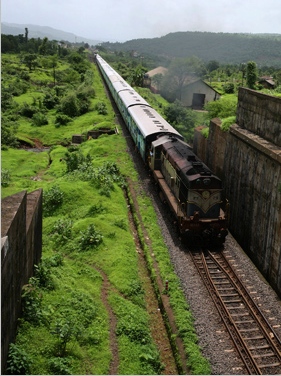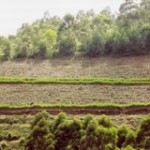Konkan railway has started to plant vetiver grass along its laterite slope to stop landsliding. Roots of vetiver grass grow at least 3 metres inside the soil and its fibrous nature bind and hold soil tightly. The roots have strength of 1/6 of mild steel (eco steel!).
The konkan railway region is one of the most scenically green belt in India. Konkan railway has been called a tech marvel for its difficult terrain, tunnels and sky bus project. It has added one more green feather to its cap. Vetiver grass is not only a green solution but it’s primary centre of origin is India.
It was long long ago when I was in school, I had seen ‘ khus ki tatti’ (vetiver roots screen) at my maternal uncle’s place. The screen was used for cooling (eco-manufacturers listening?) and it gave mild earthy aroma. I do not see vetiver roots screen anywhere now.
Among many uses vetiver grass is used for soil and water conservation. Vetiver grass is called ‘khas’ in Hindi and is used now mainly by itra (scent) manufacturers.
I have also rediscovered this-people’s-grass. Beautiful handicraft’s were used to be made from vetiver. These days I see cane and coir handicrafts but unfortunately not a vetiver grass handicraft.
I wish to revive vetiver grass craftmanship. Any artisan listening?









Mr. Grimshaw,
Thanks for such valuable info.
I could not agree more with you when you say vetiver system is “must” for India.
Hope people in power are listening.
Though I do have great faith in common people’s power.
Regards
Roma
M. P. singhji ,
Thanks for taking time to write to me.
I didnot know the story of Sita and khas. I think our mythology had a beautiful way to give importance to things we think of as unimportant.
I have bookmarked the Vetiver network.
Happy to be the part of this effort.
Regards
Roma
If you would like to see a classic application of the Vetiver System to Railroad stabilization should look at what was done in Madagascar. There a 200 km railroad was washed out regularly by cyclones. The loss of the railroad impacted on 100,000 of people. The railroad was repaired and vetiver was used to stabilize the steep cut and fill slopes. since then there have been more cyclones but no wash outs and disruptions from landslides. I refer readers to two sites: http://www.vetiver.org/ICV3-Proceedings/MAD_rail_stab.pdf2.pdf and http://www.vetiver.com/ICV3-Proceedings/MAD_rail_stab.pdf
Vetiver Systems is really a must for “India”. It could do so much for the people and country.
Dick Grimshaw. The Vetiver Network International
Roma,
It is heartening to view your post. India is indeed redicovering the little wonders it always knew about. It is said that Laxmana actually grew a hedge of “Khas” around the little hut to protect Sita from evil. She was instructed to stay within the bounds. Tha, perhaps, mythology and nothing else.
The fact is that the plant has its origin in India, yet its potential has benn seen and exploited all over the world. Now is the process of relearning.
There exists The Vetiver Network ( International). Some people have fought hard to convince decision makers in India about the diverse and seemingly unconnected uses of Vetiver.
As I write to you we are preparing for an International Vetiver Workshop in India. There is, in the making, an Indian Vetiver Network that will sponsor the workshop.
Stay in touch, to make a difference in the effort.
Best wishes,
M.P. Singh